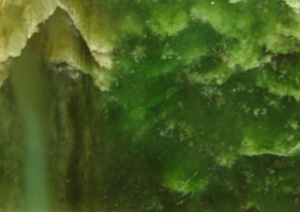
Bowenite
Encyclopedia

Serpentinite
Serpentinite is a rock composed of one or more serpentine group minerals. Minerals in this group are formed by serpentinization, a hydration and metamorphic transformation of ultramafic rock from the Earth's mantle...
species antigorite, (Mg3(OH)O4Si2O5). Classed as semi-precious gem stone it has been used for tools, weapons and jewellery by the Māori in New Zealand
New Zealand
New Zealand is an island country in the south-western Pacific Ocean comprising two main landmasses and numerous smaller islands. The country is situated some east of Australia across the Tasman Sea, and roughly south of the Pacific island nations of New Caledonia, Fiji, and Tonga...
, and for jewellery by Fabergé. Deposits are found in several places around the world including Afghanistan
Afghanistan
Afghanistan , officially the Islamic Republic of Afghanistan, is a landlocked country located in the centre of Asia, forming South Asia, Central Asia and the Middle East. With a population of about 29 million, it has an area of , making it the 42nd most populous and 41st largest nation in the world...
, China
China
Chinese civilization may refer to:* China for more general discussion of the country.* Chinese culture* Greater China, the transnational community of ethnic Chinese.* History of China* Sinosphere, the area historically affected by Chinese culture...
, New Zealand
New Zealand
New Zealand is an island country in the south-western Pacific Ocean comprising two main landmasses and numerous smaller islands. The country is situated some east of Australia across the Tasman Sea, and roughly south of the Pacific island nations of New Caledonia, Fiji, and Tonga...
, South Africa
South Africa
The Republic of South Africa is a country in southern Africa. Located at the southern tip of Africa, it is divided into nine provinces, with of coastline on the Atlantic and Indian oceans...
and the United States
United States
The United States of America is a federal constitutional republic comprising fifty states and a federal district...
. It typically ranges in colour from dark green to light olive green, and in shades approaching yellow. Bowenite was named by James D. Dana in 1850 after George T. Bowen, who analyzed it in 1822.

Ngai Tahu
Ngāi Tahu, or Kāi Tahu, is the principal Māori iwi of the southern region of New Zealand, with the tribal authority, Te Rūnanga o Ngāi Tahu, being based in Christchurch and Invercargill. The iwi combines three groups, Kāi Tahu itself, and Waitaha and Kāti Mamoe who lived in the South Island prior...
iwi
Iwi
In New Zealand society, iwi form the largest everyday social units in Māori culture. The word iwi means "'peoples' or 'nations'. In "the work of European writers which treat iwi and hapū as parts of a hierarchical structure", it has been used to mean "tribe" , or confederation of tribes,...
on whose traditional lands on the South Island
South Island
The South Island is the larger of the two major islands of New Zealand, the other being the more populous North Island. It is bordered to the north by Cook Strait, to the west by the Tasman Sea, to the south and east by the Pacific Ocean...
of New Zealand most deposits are found. Historically it was used tools, weapons and ornaments, although modern use is limited to jewellery, such as Tiki
Hei-tiki
The hei-tiki is an ornamental pendant of the Māori which is worn around the neck. Hei-tiki are usually made of pounamu which is greenstone, and are considered a taonga . They are commonly referred to as tiki, a term that actually refers to large human figures carved in wood, and, also, the small...
. The South Island deposits are legally protected, and taking material without Ngai Tahu permission has led to prosecutions. In 1992 Ngai Tahu approved the 'Pounamu Resource Management Plan' to manage deposits of this commercially valuable resource.
Bowenite is the state mineral of the US state of Rhode Island
Rhode Island
The state of Rhode Island and Providence Plantations, more commonly referred to as Rhode Island , is a state in the New England region of the United States. It is the smallest U.S. state by area...
.
Most deposits of bowenite are small, although a large deposit was discovered in South Africa in 1989. Deposits in China are in the Soochow region, which accounts for its also being known as Soochow jade.

